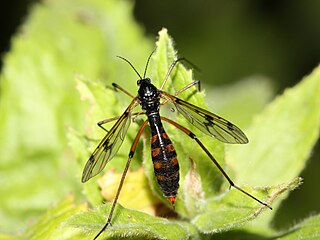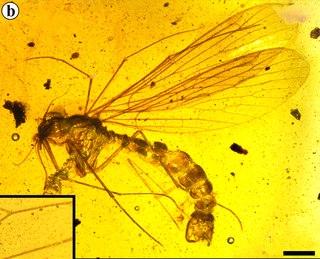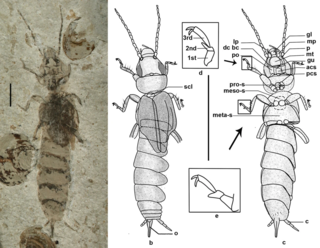
The Cupedidae are a small family of beetles, notable for the square pattern of "windows" on their elytra, which give the family their common name of reticulated beetles.

Bittacidae is a family of scorpionflies commonly called hangingflies or hanging scorpionflies.

The Ptychopteridae, phantom crane flies, are a small family of nematocerous Diptera. Superficially similar in appearance to other "tipuloid" families, they lack the ocelli of the Trichoceridae, the five-branched radial vein of the Tanyderidae, and the two anal veins that reach the wing margins of the Tipulidae. They are usually allied with the Tanyderidae based on similarities of the mesonotal suture, this group being called the Ptychopteromorpha.

Orussoidea is a superfamily of sawflies. It contains the living family Orussidae, as well as the extinct families Burmorussidae and Paroryssidae. They are the group of sawflies closest to the Apocrita, the group containing wasps, bees and ants, with both groups together forming the clade Euhymenoptera. Like most members of Apocrita, but unlike other sawflies, members of the superfamily are parasitoids.

Osmylidae are a small family of winged insects of the net-winged insect order Neuroptera. The osmylids, also called lance lacewings, stream lacewings or giant lacewings, are found all over the world except North and Central America. There are around 225 extant species.

Pelecinidae is a family of parasitic wasps in the superfamily Proctotrupoidea. It contains only one living genus, Pelecinus, with three species known from the Americas. The earliest fossil species are known from the Jurassic, and the group was highly diverse during the Cretaceous. Members of Pelecinus are parasitic on larval beetles, flies, green lacewings, and sawflies.

Nemonychidae is a small family of weevils, placed within the primitive weevil group because they have straight rather than geniculate (elbowed) antennae. They are often called pine flower weevils. As in the Anthribidae, the labrum appears as a separate segment to the clypeus, and the maxillary palps are long and projecting. Nemonychidae have all ventrites free, while Anthribidae have ventrites 1-4 connate or partially fused. Nemonychidae lack lateral carinae on the pronotum, while these are usually present, though may be short, in Anthribidae.

The Berothidae are a family of winged insects of the order Neuroptera. They are known commonly as the beaded lacewings. The family was first named by Anton Handlirsch in 1906. The family consists of 24 genera and 110 living species distributed discontinuously worldwide, mostly in tropical and subtropical regions. Numerous extinct species have also been described. Their ecology is poorly known, but in the species where larval stages have been documented, the larvae are predators of termites.
Eolepidopterigoidea is an extinct superfamily of moths, containing the single family Eolepidopterigidae, although the genus Undopterix is sometimes placed in a separate family Undopterigidae. The type-genus of the family is Eolepidopterix.

Heloridae is a family of wasps in the order Hymenoptera known primarily from fossils, and only one extant genus, Helorus, with 12 species found worldwide. Members of Helorus are parasitic on green lacewings.

Roproniidae is a family of wasps in the order Hymenoptera, of which only two genera are still extant, the others being fossils.
Karatavitidae is an extinct family of sawflies, known from the Jurassic period, they are the only members of the superfamily Karatavitoidea. While once proposed to be grouped with the Orussoidea in the infraorder Orussomorpha, they are now considered to be the closest relatives of clade containing Orussoidea and Apocrita. There are about 7 genera in Karatavitidae.

Pseudopolycentropodidae is an extinct family of scorpionflies known from the Mesozoic. Fossils are known from the Middle Triassic (Anisian) to the early Late Cretaceous (Cenomanian). It is part of Mesopsychoidea, a group of scorpionflies with siphonate proboscis. They are suggested to have been nectarivores, feeding off the liquid pollination drops and acting as pollinators for now extinct insect pollinated gymnosperms such as Bennettitales.

Aneuretopsychidae is an extinct family of scorpionflies known from the Mesozoic. Fossils are known from the Jurassic (Callovian-Oxfordian) to the early Late Cretaceous (Cenomanian). It is part of Mesopsychoidea, a group of scorpionflies with siphonate proboscis. They are suggested to have been nectarivores, feeding off the liquid pollination drops of and acting as pollinators for now extinct insect pollinated gymnosperms such as Bennettitales.

Eodermaptera is an extinct suborder of earwigs known from the Middle Jurassic to Mid Cretaceous. Defining characteristics include "tarsi three-segmented, tegmina retain venation, 8th and 9th abdominal tergite in females are narrowed, but separate from 10th tergite and not covered by 7th tergite and exposed ovipositor" They are considered to be more closely related to Neodermaptera than the more basal Archidermaptera.
Mesoblattinidae is an extinct, problematic family of cockroaches known from the Mesozoic. It was formerly considered a wastebasket taxon for Mesozoic cockroaches, but the family has subsequently been better defined, with many taxa transferred to Caloblattinidae. It is considered to have close affinities with Blattidae and Ectobiidae, as well as possibly Blaberidae. The family first appeared by the Early Jurassic. They are considered to represent amongst the oldest groups of modern cockroaches, and like them are thought to have laid oothecae.
Rhagionemestriidae is an extinct family of brachyceran flies known from the Jurassic and Cretaceous periods. It was first named as a subfamily of the Nemestrinidae by Ussatchov (1968), and was raised to full family status by Nagatomi and Yang (1998). They are considered to be closely related to the family Acroceridae. Similar to Acroceridae, members of the family possess a large hemispherical head, with eyes covering nearly all of the area.

Archisargidae is an extinct family of brachyceran flies known from the Jurassic and Cretaceous periods. It is part of the extinct superfamily Archisargoidea. Most members of the family are known from the Callovian-Oxfordian Daohugou biota of Inner Mongolia, China, and the equivalently aged Karabastau Formation of Kazakhstan. The family has been found to be paraphyletic with respect to Eremochaetidae in a cladistic analysis.
Praeaulacidae is an extinct family of Mesozoic parasitic wasps in the suborder Evanioidea. It among the earliest known families of the group and is characterised by more complete wing venation in comparison to other members of the suborder. It has been found that Othniodellithidae is nested within Praeaulacidae via cladistic analysis.
Mesochrysopidae is an extinct family of lacewings known from the Jurassic and Cretaceous periods. They are considered to be closely related to green lacewings of the family Chrysopidae. The family are also alternatively considered a paraphyletic grade leading up to crown Chrysopidae.














